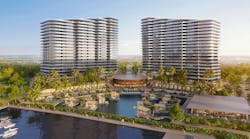Two Faces of justice
A federal courthouse used to be easily identified by traditional features such as columns and domes. Courthouses completed more recently do not telegraph their nature so readily. While they may retain some features that are traditional earmarks of federal buildings, their association with the national government is not as obvious. Their distinctly individual designs more strongly reflect not only functional needs but also the context of their immediate surroundings.
Two buildings that illustrate this trend are located only 250 miles apart in the same state.
They are the Thomas F. Eagleton Courthouse in St. Louis, the work of that city's Hellmuth, Obata + Kassabaum (HOK) and occupied in June 2000; and the Charles Evans Whittaker Courthouse in Kansas City, Mo., designed by the local office of Ellerbe Becket, in association with ASAI Architecture of Kansas City, and completed in September 1998. The General Services Administration (GSA) became general contractor after dismissing Morse Diesel (now AMEC) from the Eagleton project. J.E. Dunn Construction was general contractor for the Whittaker Courthouse.
Although they house similar functions, each building has been tailored to meet specific site and program requirements.
One challenge for each team was to find ways to get more light into the courtrooms, a practice that's becoming popular in federal justice facilities once again, after two decades of dungeon-like darkness.
But a more nettlesome problem for the Building Teams was accommodating specific numbers of courtrooms and related spaces into each structure, while meeting rigorous GSA guidelines and other programming considerations.
The return of natural light
Federal courtrooms traditionally had windows, until the 1970s ushered in "20 years of building dungeons," says Ed Feiner, GSA's chief architect. That era produced "lots of ugly buildings and buildings that were not humanitarian in their orientation," he adds.
A renewed interest in the use of natural light re-emerged in the early 1990s, and courtroom windows are being incorporated in almost all the new courthouses, he says.
Both the Eagleton and Whittaker courthouses have daylighted courtrooms. All but one of the Eagleton Courthouse's 25 courtrooms have large windows that bring light into the spaces and offer city views. A side wall of each courtroom is two-story, floor-to-ceiling glass framed in a stainless steel grid.
Full-height glazing on the front elevation of the Whittaker Courthouse allows natural light to illuminate courtrooms, reducing the need for artificial lighting and contributing to the building's open environment.
Making room for justice
Providing more natural light was nothing compared to the problems associated with meeting the programming needs of the buildings' occupants, particularly the federal judges, and the General Services Administration.
The Eagleton building houses both the Eighth Circuit Court of Appeals and the Eastern District Court of Missouri.
Enclosing more than 1 million sq. ft., it is now the GSA's largest (although a planned courthouse in Los Angeles may someday be larger). Its exterior and interior designs reflect a compromise between program needs and site constraints.
A key goal of the Eagleton design was to provide same-floor adjacency for 25 courtrooms and judges' chambers. But site constraints made it difficult to achieve that goal.
For example, placing six courtrooms per floor created a footprint too large for the tight site and future expansion needs, while limiting the design to two courtrooms per floor would have made the building taller than the 630-ft. Gateway Arch — an absolute no-no in St. Louis.
Four courtrooms per floor, while more desirable, was still too large a footprint for on-site expansion. It also carried the penalty of volumetric inefficiency due to the differing height requirements of courtrooms, judges' chambers, and support space.
The four-courtroom configuration would have given the building "humongous" girth and "the appearance of a big refrigerator," according to HOK design director Steve Brubaker.
The solution was quite ingenious, as the accompanying illustration shows.
Eagleton has four courtrooms per floor, in a unique arrangement. On even-numbered floors, 2,400-sq.-ft District courtrooms are laid out on the east side of the building. On odd-numbered floors, 1,800-sq.-ft. Magistrate courtrooms are on the west side. Courtrooms are staggered vertically, while judges' chambers are stacked.
This technique of staggering the courtrooms, which represent 30% of the area of a typical floor, permitted the support areas, representing 70% of the floor area, to stack two high for each courtroom yet continually align with each courtroom.
"Staggering the courts and judges' chambers was the key that unlocked a critical part of the design solution, after which all the pieces fell into place," says HOK chairman Gyo Obata.
This configuration satisfied the judges' expressed need for adjacencies of courtroom and judges' chambers, while allowing the building to have more pleasing exterior proportions and fit more easily on its tight site.
At the Kansas City site, the designers of the Whittaker Courthouse faced similar programming issues.
Providing enough space for the required 16 courtrooms of the Whittaker Courthouse could have had the undesired result of making the building taller than City Hall, according to Michael Sabatini, design principal with Ellerbe Becket.
Four courtrooms per floor would have been an optimum arrangement. However, the site was not large enough for them to be placed in a linear fashion.
The solution devised by Ellerbe Becket and ASAI Architecture called for rotating the courtrooms around the building axis into a crescent shape, yielding five courtrooms per floor. A full-height, south-facing wedge cut out of the crescent highlights the main building entrance.
One construction worker described the resulting plan as "a huge donut with a bite taken out of it." This glazed wall also channels the view of building occupants directly to the planned mall and the City Hall beyond it.
Local input is critical
GSA encourages design architects to collaborate with architects who practice in the geographic area of the project, and requires that collaborators perform at least 35% of the design work, Feiner says. The infusion of local designers is intended to ensure that sensitivities and knowledge are completely integrated with respect to materials, scale, and urban design issues. The selected architect is required to develop three "distinctly different" designs for presentation to GSA.
"We want to participate as a knowledgeable client in narrowing down the design options," Feiner says. GSA works with a group of notable architects who peer review its projects. The Administrative Office of the Courts issues a design guide, updated periodically, that covers topics such as program requirements, square footage allocations and other factors that affect the operation of the court (e.g., district courtrooms generally have a ceiling height of 16 feet). The agency has additional requirements of a federal nature covering issues such as sustainability, security, earthquake protection and energy conservation.
GSA implements the goals of the 1962 "Guiding Principles for Federal Architecture," which provides that facilities "reflect the dignity, enterprise, vigor and stability of the federal government, emphasizing designs that embody the finest contemporary architectural thought and avoiding an official style."
GSA has made its program more available to smaller design firms. Under its current system, the cost of assembling a portfolio to enter the first phase of the selection process is about $3,000. Previously, the cost of entering the first phase was about $20,000.
Justice's next generation
The St. Louis and Kansas City buildings hint at the direction of courthouse designs to come.
Last month, ground was broken for a 542,000-sq.-ft. courthouse in Miami that was designed by Miami-based Arquitectonica, in collaboration with HOK. It will be surrounded by an arboretum and a botanical garden, and its lobby will feature a 200-ft. tall glass cone.
Scheduled to begin construction this year in Eugene, Ore., is a courthouse designed by Santa Monica, Calif.-based Morphosis. Feiner likens it to a Frank Gehry design.
Awaiting funding, which may be approved in the next year or two, is a 50-story courthouse in Los Angeles that was designed by Ralph Johnson of Chicago-based architect Perkins & Will. It is the firm's first GSA commission.
Courthouses compared
| Eagleton (St. Louis) | Whittaker (Kansas City) | |
| Height | 557 ft. | 250 ft |
| Number of stories | 29 floors plus below-grade parking | 11 |
| Gross square footage | 1.038 million | 565,000 |
| Size of site | 5.5 acres | 6 acres |
| Number of courtrooms | 25 | 16 |
| Architect | Hellmuth, Obata + Kassabaum | Ellerbe Becket/ASAI Architecture |
| Completion | June 2000 | September 1998 |
| Construction costs | $195.2 million | $106.2 million |
| Design Challenge: Providing required courtroom in a compact plan | ||
| Solution | Courtrooms are staggered vertically; judges' chambers are stacked | Courtrooms are arranged in a crescent shape around the building axis |
| Design Challenge: Introducing daylight into the courtrooms | ||
| Solution | All but one of the building's 25 courtrooms have large windows allows natural light to enter the courtrooms | Full-height glazing on the front elevation |

